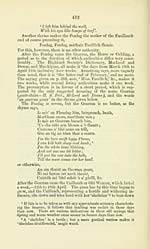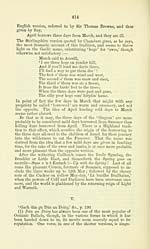Download files
Complete book:
Individual page:
Thumbnail gallery: Grid view | List view

413
the grass, and keep it from growing. Finding her efforts vain, she
flings away her mallet in wratli, and vanishes with a shriek into
the realm ol' Kiglit, exclaiming,
Dh' Ihàg e shios mi, dh' fhàg e shnas mi,
Dh' fhàg e eadar mo dhà chìuais mi ;
Dh' fhàg e thall mi, dh'iliàg e bhos mi,
Dh' fhàg e eadar mo dhà chois mi ;
Tilgeam seo 'am bnn preas cuilinu,
Far nach fas fiar no duilleach !
It escapes me up and down,
'Twixt my very ears has flown ;
It escapes me here and there,
'Twixt my feet and everywhere ;
This 'neath holly tree Fll throw,
Wliere no grass nor leaf shall grow !
This is a lively description, and the selection of the holly in par-
ticular shows felicitous accuracy.
After the abortive attempt of the Cailleach, the time came to
sow, and that quamprimum : —
Ge b'e 'r bith mar bhios an t-sian,
Cuir do shiol anns a' Mhàrt.
The ' Mart ' corresponded probably to the month of March, but
it was used as a term for the sowing-season, more than for any
definite period. The term 'Gibleann,' in like manner was ap-
plied to the month of April. See ' Am fiar,' &c., p. 24.
Another period not so commonly mentioned is the 'Gobag,'
Little-Gab, or Dog-fish, sometimes called a week, sometimes
three days, and coming in apparently between the Feadag and
the Gearran. A saying that refers to it is,
Feadagan 'us Gobagan e, tuiUeadh gu Feill-Pàruig,
which may be rendered,
Whistling and biting winds on to St. Patrick's day,
i.e., 30th March, O.S., when the equinoctial gales and worst
weather should have passed.
' Neòil dhubha na Càisge,' the dark clouds of Easter, came in
the fourth week of March, followed by the ' Glasadh na Cubhaig,'
the cuckoo's greening, or preparation time.
The Oisgean or Ewes, called 'tri la nan Oisgean,' the three days
of the Ewes, or 'la nan tri Oisgean,' the day of the three Ewes,
were three days immediately following the Cailleach, which
would bring them into the third week of April, O.S. The name
suggests the "three borrowing days" of the Lowlands, but the
period and character of the ' Oisgean ' is quite different. Accord-
ing to the Lowland tradition (Chamlers' Pop. Ehymes of Scotland,
pp. 143, 4 ; Book of Days, I., 448) these three days were the last
of March, and said to be borrowed from April. According to the
the grass, and keep it from growing. Finding her efforts vain, she
flings away her mallet in wratli, and vanishes with a shriek into
the realm ol' Kiglit, exclaiming,
Dh' Ihàg e shios mi, dh' fhàg e shnas mi,
Dh' fhàg e eadar mo dhà chìuais mi ;
Dh' fhàg e thall mi, dh'iliàg e bhos mi,
Dh' fhàg e eadar mo dhà chois mi ;
Tilgeam seo 'am bnn preas cuilinu,
Far nach fas fiar no duilleach !
It escapes me up and down,
'Twixt my very ears has flown ;
It escapes me here and there,
'Twixt my feet and everywhere ;
This 'neath holly tree Fll throw,
Wliere no grass nor leaf shall grow !
This is a lively description, and the selection of the holly in par-
ticular shows felicitous accuracy.
After the abortive attempt of the Cailleach, the time came to
sow, and that quamprimum : —
Ge b'e 'r bith mar bhios an t-sian,
Cuir do shiol anns a' Mhàrt.
The ' Mart ' corresponded probably to the month of March, but
it was used as a term for the sowing-season, more than for any
definite period. The term 'Gibleann,' in like manner was ap-
plied to the month of April. See ' Am fiar,' &c., p. 24.
Another period not so commonly mentioned is the 'Gobag,'
Little-Gab, or Dog-fish, sometimes called a week, sometimes
three days, and coming in apparently between the Feadag and
the Gearran. A saying that refers to it is,
Feadagan 'us Gobagan e, tuiUeadh gu Feill-Pàruig,
which may be rendered,
Whistling and biting winds on to St. Patrick's day,
i.e., 30th March, O.S., when the equinoctial gales and worst
weather should have passed.
' Neòil dhubha na Càisge,' the dark clouds of Easter, came in
the fourth week of March, followed by the ' Glasadh na Cubhaig,'
the cuckoo's greening, or preparation time.
The Oisgean or Ewes, called 'tri la nan Oisgean,' the three days
of the Ewes, or 'la nan tri Oisgean,' the day of the three Ewes,
were three days immediately following the Cailleach, which
would bring them into the third week of April, O.S. The name
suggests the "three borrowing days" of the Lowlands, but the
period and character of the ' Oisgean ' is quite different. Accord-
ing to the Lowland tradition (Chamlers' Pop. Ehymes of Scotland,
pp. 143, 4 ; Book of Days, I., 448) these three days were the last
of March, and said to be borrowed from April. According to the
Set display mode to: Large image | Transcription
Images and transcriptions on this page, including medium image downloads, may be used under the Creative Commons Attribution 4.0 International Licence unless otherwise stated. ![]()
| Early Gaelic Book Collections > J. F. Campbell Collection > Collection of Gaelic proverbs and familiar phrases > (457) |
|---|
| Permanent URL | https://digital.nls.uk/78593844 |
|---|
| Description | Volumes from a collection of 610 books rich in Highland folklore, Ossianic literature and other Celtic subjects. Many of the books annotated by John Francis Campbell of Islay, who assembled the collection. |
|---|
| Description | Selected items from five 'Special and Named Printed Collections'. Includes books in Gaelic and other Celtic languages, works about the Gaels, their languages, literature, culture and history. |
|---|

